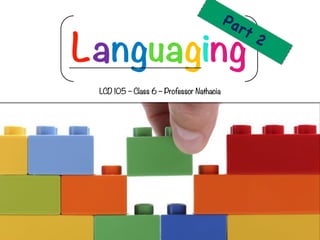
Class6 - Languaging - part 2
- 1. LCD 105 – Class 6 – Professor Nathacia Languaging Part 2
- 4. Lexicology What is this about: - The vocabulary; words inventory, and how they relate within a language. What is its unit: - The words What organizes its internal structure: - Word paradigms; scope; webs. What are some of its sub-levels/ categories: - Lexical semantics; phraseology; etymology; lexicography
- 6. Metonym Metonymy is a figure of speech in which a thing or concept is referred to by the name of something closely associated with that thing or concept. Example: I fueld my car (instead of “I fueld the gas tank of my car”) Hypernym and Hyponym Hyponymy shows the relationship between a generic term (hypernym) and a specific instance of it (hyponym). A hyponym is a word or phrase whose semantic field is more specific than its hypernym. The semantic field of a hypernym, also known as a superordinate, is broader than that of a hyponym. An approach to the relationship between hyponyms and hypernyms is to view a hypernym as consisting of hyponyms.
- 9. Morphology What is this about: - The smallest meaning units of a language (meaning you can take for ‘functional’ too). What is its unit: - The morphemes What organizes its internal structure: - Morphological Rules; Morphological Restrictions. - Morpheme-based, lexeme-based and word-based approaches. What are some of its sub-levels/ categories: - Stems; root words; prefixes; suffixes; infixes, clitics.
- 10. Categorizer Morphemes ‣ Derivational morphemes Derivational morphemes, when combined with a root, change either the semantic meaning or part of speech of the affected word. For example, in the word happiness, the addition of the bound morpheme -ness to the root happy changes the word from an adjective (happy) to a noun (happiness). In the word unkind, un- functions as a derivational morpheme, for it inverts the meaning of the word formed by the root kind. Generally, the affixes used with a root word are bound morphemes. ‣ Inflectional morphemes Inflectional morphemes modify a verb's tense, aspect, mood, person, or number, or a noun's, pronoun's or adjective's number, gender or case, without affecting the word's meaning or class (part of speech). Examples of applying inflectional morphemes to words are adding -s to the root dog to form dogs and adding -ed to wait to form waited. An inflectional morpheme changes the form of a word. In English, there are eight inflections.
- 12. Morphemes has hierarchical structure Morphemes have structure, and many language use its structure to built syntax structure. That’s why some theories call it morphosyntactic structure
- 13. Video Barney Stinson – Wait For It Compilation https://youtu.be/SqkYnfAhgy0
- 16. Phonology What is this about: - The distinctive sound units of a language. What is its unit: - It depends on its sub-level: phonological features; phonemes; syllables; foot; intonational phrases; and others. What organizes its internal structure: - Phonological Rules; Phonological Restrictions. What are some of its sub-levels/ categories: - Segmental phonology; auto-segmental phonology; Intonational Phonology; Prosody;
- 17. Identifying units in a sea Linguistic VALUE and PARADIGMATIC relations determine what are the phonemes of a language
- 18. Valuable Units • Minimal pairs -> What a phoneme is (minimal distinctive unit): Ex. dot x dog • Analog pairs -> What a phoneme in complementary distribution is (they do not occur in the exact same context): Ex. /t/ in tea vs. tree vs. British vs. Manhattan vs. eat. • Phonemes in free variation (due to social factors; irrelevant to the system)
- 19. At Macy’s: - Where can I find Men’s shoes? - 4th floor. (Labov) Valuable Units
- 20. [fɔɹθ flɔɹ] [fɔɻθ flɔɻ] Valuable Units
- 21. • There is NO direct correspondence between lettersand phonemes! • Examples: Sad; Laugh; Fase; (Gussenhoven & Jacobs, 2011) Valuable Units
- 22. The melodic Structure • The Phonology level is where the units are arranged into melodic structure. • It is an hierarchical structure (as all language structures are). • Some levels: syllable , foot, phonological word, intonational phrase.
- 23. The World of DAVE [Difference in Pronunciation between English/Korean/Japanese+Chinese 2] https://youtu.be/2jMddKVDwUU
- 24. Phonetics What is this about: - The sounds of language/ speech. What is its unit: - It doesn’t have a proper unit but it is composed by sound waves. What organizes its internal structure: - Speech restrictions as breath, co-articulation, phonation conditions, articulation conditions, propagation condition etc. What are some of its sub-levels/ categories: - Acoustic Phonetics; Articulatory Phonetics; Perceptual Phonetics;
- 26. Summing Up: - We can count eight different levels to language structure; - They are: Discourse; Pragmatics; Semantics; Syntax; Lexicon; Morphology; Phonology; and Phonetics. - The criteria to determine those levels are based on its units and its way of operating those units. - Each level unit is composed by the integration of lower lever units; - But the lower level units are inaccessible to the upper level (the new units become opaque); - Each level can be investigated and analyzed by many different approaches.
